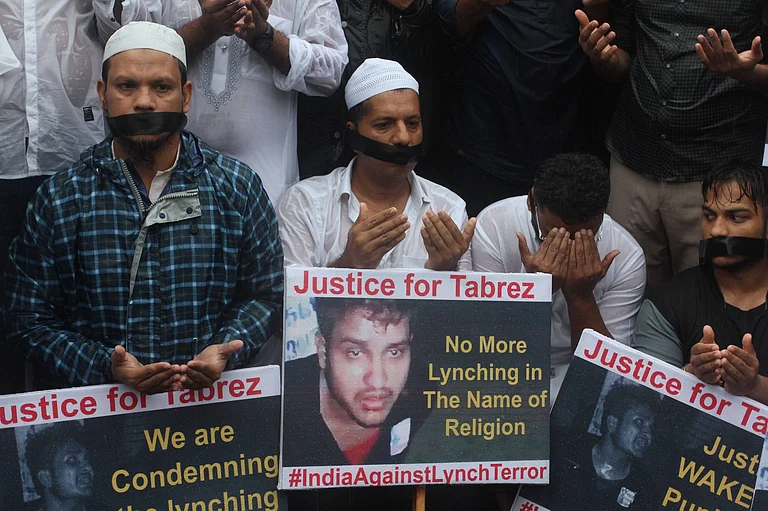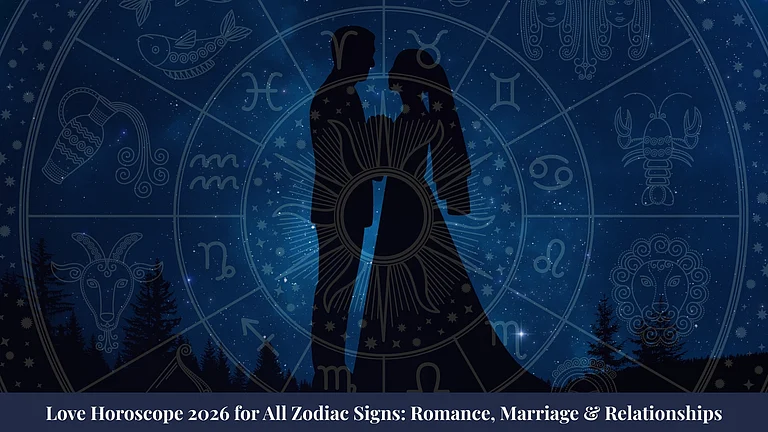A note on photographing Uzbekistan in the season of Chilla, the 40 hottest days of June and July: It is confounding, this strong, overpowering light throwing everything in the frame into extremes. There is no middle ground, only the black of shade and the stark, blinding white of sunshine. In a sense this serves as a metaphor for the extremes of this land. Temperatures that range from 42 degrees Celsius in summer to -30 in winter, geography that includes harsh desert and verdant valleys, a history that has accommodated the devastating invasions of Alexander and Chengiz Khan as well as philosophies as diverse as Zoroastrianism, Buddhism, Judaism, and Islam to the now extinct traditions of Manicheanism and Nestorian Christianity. If there were periods of blighted darkness there were also periods of extraordinary illumination, where the cities of Samarkand and Bokhara, situated smack in the middle of the caravan route between the west and China, glowed with the fabled wealth of its buildings, and its stars: the philosophers, artists and artisans, poets and scientists.
KHIVA
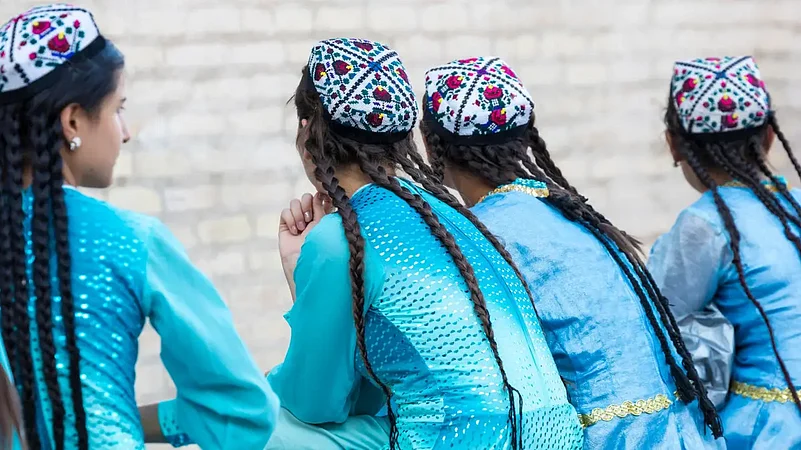
I stood in front of the walled city, before the magnificent statue of Al-Khorezmi, geographer, astronomer and mathematician of the 9th century. Khorezm is the old name that describes this area, and the scientist spent his early years here before writing his famous Al-Jabrwa-al-Muqabilah, from which we have got Algebra. Al-Khorezmi introduced the Indian system of numerals to the world (wrongly credited to the Arabs), explained the use of zero, as well as developed the decimal system. Therefore, Al-Khorezm equals Algorithm. Later in Bokhara, I would realise that Ibn Sena (Avicenna) whom I always considered Arab was actually a son of Uzbekistan who gave the world the first medical canon (Qanoon) in the 10th century. His friend and partner Al Beruni discovered the earth was round and went around the sun. In Samarkand, it was the 14th-century astronomer-king Ulug Beg, Timur's grandson, who challenged religious orthodoxy, encouraged scientific debate, charted the coordinates of over a thousand stars and computed the solar year to within one minute of present-day calculations.
Is it this tradition that tempers the Islam I see on display every day? I follow a newly married couple and their joyous entourage as they wend their way through the streets of the old city. It is not some mullah in a mosque they seek blessings from but Pahlvan Mahmud, a 13th-century wrestler who, legend has it, freed 5,000 Khorezmi slaves by travelling to India and winning them all in a wrestling match.
BOKHARA
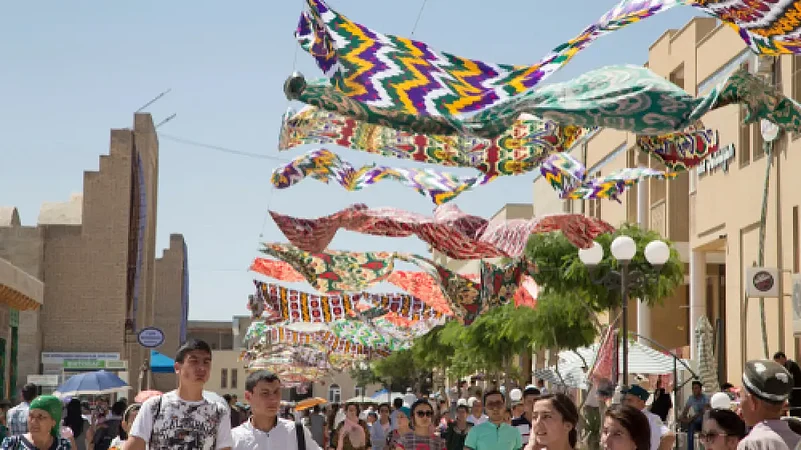
Sitting in the empty courtyard of the Grand Mosque of the Poi Kalyan complex, it is serene and quiet. The evening prayers have not yet begun. The dying sun sets the minarets aglow and casts deep blue shadows in the iwans. Difficult to imagine the scene in 1219 when Chengiz Khan rode in and ordered all the Korans brought out to the courtyard only to be trampled under the hooves of his horses before sacking the city. It has since survived many more traumas and indignities and yet greets visitors with an unsurpassed grace.
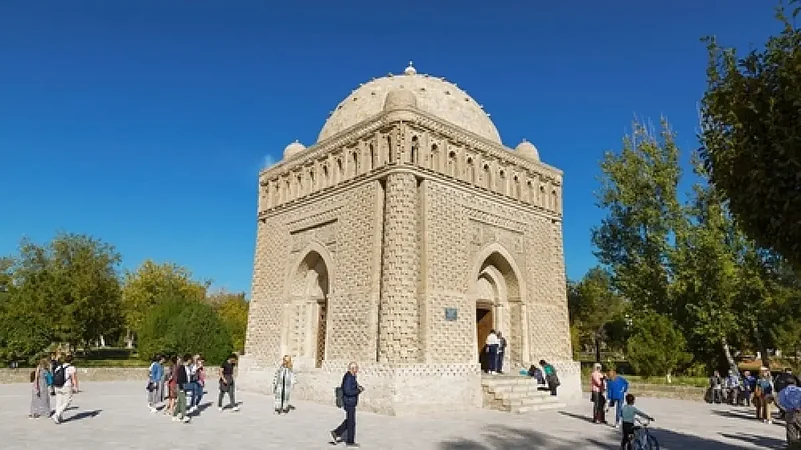
Early yesterday, at the exquisite 10th-century Samanid Tomb there appeared half a dozen white-bearded ulema wearing traditional embroidered caps, frock coats and knee-length leather boots. While waiting for the caretaker to open the doors, mistaking me for a local lad, they struck up a conversation. Discovering soon enough that they were mistaken on both counts, they scuttled off into a corner to engage in animated discussion. Oh dear, I thought with some weariness, I must have offended them somehow. But no, sudden shouts, hoots and waving of arms across the courtyard, “Raj Kapoor! Raj Kapoor!”
Later that night we find a table right by the waters at Lyabi Hauz. Festive air with lots of locals, fairy lights on trees, fountains cooling the desert air, loud, jolly Uzbek music. We order a bottle of Omar Khayyam, a nice local wine. In no time a large Uzbek family at the next table befriends us, and after vast quantities of shashlik, beer and wine have been consumed they get up to dance, men, women, children, and even the toothless old granny. I am summoned and since I am in fine spirits I oblige and have a grand time, all the while aware of the moonlight and the grace, and the barkat of the moment, dancing with strangers in Central Asia.
SHAKHRISABZ
I figure this is Shahr-i-sabz, green city. Here the grass is lush, flowers abundant, and oaks, poplars and chinars line the streets. It is a small but charming place, this ancient capital of Timur's before he decided to lavish care and attention on Samarkand. The ruins of the Ak Saray, Timur's White Palace, have a robust, masculine quality that I like. The ruined tiles reveal rather than conceal the muscular mud-brick masonry, just hints of delicate blue on the solidness of earth. Later, we walk over to the Kok Gumbaz mosque and Taraghay's (Timur's father's) mausoleum. From outside yet another set of dun-coloured walls and turquoise domes, but inside a charming courtyard awaited us with a small walnut tree that provided generous shade. Under it someone had thoughtfully placed two benches, upon which we now sat and yarned about Buzkashi, the rough-riding Central Asian variant of our polo. Utkir, my guide, explains how it is a national obsession. From autumn to early spring, at weddings and sunnats generous prize money attracts competitors all the way from Turk-menistan, Kyrghyztan, and Afghanistan. Many horses, riders and even spectators lose their lives, but the game remains popular. Utkir recalls how his brother suffered from a concussion after a horse stumbled and fell on him. When he came to, he asked, “How is the horse?”
SAMARKAND
If Chengiz Khan killed some five million people, Timur slaughtered 17 million on his campaigns. And yet Timur was far from an avenging barbarian. He dazzled his subjects by rebuilding Samarkand, an ancient city flattened by the Mongol storm, into a city of unrivalled magnificence and artistic excellence.
“Let he who doubts our power look upon our buildings,” said Timur. Who would? Wandering around for hours in the Shah-i-Zindan necropolis I am stunned and left speechless by the sheer beauty of the glazed tiles that adorn the mausoleums of the Timurids and their followers. Many delightful discoveries: the relationship of curves to each other; the curve of a dome echoed in smaller domes around it, reflected in the curve of a minaret or the half-swoop of an arched gateway. The infinite shades of blue of tiles: the longing of a people surrounded by desert for fresh, running water?
ANDIJON, FERGHANA VALLEY
“I think he was a writer or a poet,” Ghulam says at last. Utkir glares at him.
“Well, he's not entirely wrong,” I say, raising my voice against the din of the chaikhana. “He authored one of the greatest first lines of autobiography. Listen: 'In the month of Ramadan in the year 899, in the province of Ferghana, in my twelfth year I became king.' Fantastic! But why is it that people here know so little about him?”
“You ask the wrong people. He doesn't know history. Anyway, so much of it was wiped out in the Soviet era. You should ask someone a little older, someone from Ferghana.” The waitress bustles up to our table with our lunch. She is middle-aged and has large, intelligent eyes. I try again.
“Babur was our king in the old days. He then went on to conquer Hindustan,” she says without a pause. I am impressed, but can't resist a cross-examination. “And the names of his son, grandson and great-grandson, do you know them?” “Yes, his son was Akbar Shah, and grandson Shah Jehan,” she says confidently.
“Wrong! His son was Humayun, grandson Akbar, great-grandson Jehangir and great-great grandson Shah Jehan. And now tell her,” I turn to Utkir chuckling, “Babur may have been king of Ferghana, but he was Emperor of Hindustan. He belongs to us now and forever!” Utkir and Ghulam laugh. The waitress smiles and leaves abruptly.
I am famished after the long drive from Tashkent and attack the food in earnest, washing it down with a refreshing drink made from fresh cherries. As I down my third cup, the waitress returns. I look up and see her looking at me with large, solemn eyes, hand on heart. What I hear next shames me. My teasing seemed crass and misplaced in the face of such old-world courtesy. “She wishes to apologise,” Utkir explained, “She says she was a teacher 10 years ago and she taught students history. She knew all this and has now forgotten. She says she is very sorry, but still she feels very happy that you have come all the way from Hindustan to see Babur's birthplace.”
All through the journey I had wondered why the Mughal emperor had spurned verdant India only to hanker after the deserts of Central Asia. The melon came to symbolise all that Babur missed. When someone sent him one, Babur confessed: “...as I cut and ate it I was oddly affected. I wept the whole time I was eating it.” The man who skinned his enemies alive prone to excessive sentimentality while skinning fruit? I was determined to taste the melons of Andijon and compare them with the ones I had devoured in Delhi through the summer. We drop in on the Friday market near the Juma Masjid. There are hillocks of melons everywhere of every possible size, shape and colour. I must look stricken as Utkir comes swiftly to the rescue. “We'll try this variety. It's called Amiri.” “How much?” he asks the melon man. “1,200 cym,” comes the non-negotiable reply. “Why?” Utkir glares, “Did you bring it all the way from Hindustan?”
The next morning I slice it for breakfast. The skin is as thin as a cucumber's. The juice runs down my fingers. I bite into it. Not just sweet, but fragrant, with hints of the sweet mountain air that sweeps down from the Tien Shan and Pamirs...Yes, really quite divine. I find my eyes misting up.
The information
What To See & Do
All the important architectural and archaeological sites are part of every tour itinerary. This aside, there are lovely museums in Tashkent, Buzkashi games for the adventurous, and chaikhanas and parks for the dreamers. Shoppers can pick up gorgeous rugs, blue pottery, silver jewellery, 'kagzi' almonds, dried apricots, and cheap caviar.
When To Go
Spring (April-May) and autumn (end of August-October) are best, when temperatures are a comfortable 20-30 degrees.
Top Tip
Horse whisperer: Stories of 'heavenly horses' that sweated blood caused the Chinese to invade Ferghana in 150 BC. Renowned for its beauty, speed and endurance, the Akhal Teke is still a breed that equestrian aficionados lust after, paying as much as $100,000 for a good horse. I scoured the countryside and came up with naught, finally tracking them down at an equestrian centre just outside Tashkent. Horse lovers should not miss a visit to the Tashkent 'Jokey' Club where you can watch these rare creatures taking their evening exercise.
This story is from our archives. It was first published in 2014









